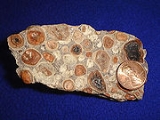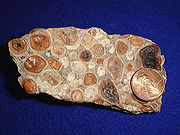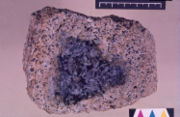
Bauxite
Encyclopedia


Aluminium
Aluminium or aluminum is a silvery white member of the boron group of chemical elements. It has the symbol Al, and its atomic number is 13. It is not soluble in water under normal circumstances....
ore
Ore
An ore is a type of rock that contains minerals with important elements including metals. The ores are extracted through mining; these are then refined to extract the valuable element....
and is the main source of aluminium. This form of rock consists mostly of the mineral
Mineral
A mineral is a naturally occurring solid chemical substance formed through biogeochemical processes, having characteristic chemical composition, highly ordered atomic structure, and specific physical properties. By comparison, a rock is an aggregate of minerals and/or mineraloids and does not...
s gibbsite
Gibbsite
Gibbsite, Al3, is one of the mineral forms of aluminium hydroxide. It is often designated as γ-Al3 . It is also sometimes called hydrargillite ....
Al(OH)3, boehmite
Boehmite
Boehmite or Böhmite is an aluminium oxide hydroxide mineral, a component of the aluminium ore bauxite. It is dimorphous with diaspore. It crystallizes in the orthorhombic dipyramidal system and is typically massive in habit. It is white with tints of yellow, green, brown or red due to impurities...
γ-AlO(OH), and diaspore
Diaspore
Diaspore is a native aluminium oxide hydroxide, α-AlO, crystallizing in the orthorhombic system and isomorphous with goethite. It occurs sometimes as flattened crystals, but usually as lamellar or scaly masses, the flattened surface being a direction of perfect cleavage on which the lustre is...
α-AlO(OH), in a mixture
Mixture
In chemistry, a mixture is a material system made up by two or more different substances which are mixed together but are not combined chemically...
with the two iron oxide
Iron oxide
Iron oxides are chemical compounds composed of iron and oxygen. All together, there are sixteen known iron oxides and oxyhydroxides.Iron oxides and oxide-hydroxides are widespread in nature, play an important role in many geological and biological processes, and are widely utilized by humans, e.g.,...
s goethite
Goethite
Goethite , named after the German polymath Johann Wolfgang von Goethe, is an iron bearing oxide mineral found in soil and other low-temperature environments. Goethite has been well known since prehistoric times for its use as a pigment. Evidence has been found of its use in paint pigment samples...
and hematite
Hematite
Hematite, also spelled as haematite, is the mineral form of iron oxide , one of several iron oxides. Hematite crystallizes in the rhombohedral system, and it has the same crystal structure as ilmenite and corundum...
, the clay mineral kaolinite
Kaolinite
Kaolinite is a clay mineral, part of the group of industrial minerals, with the chemical composition Al2Si2O54. It is a layered silicate mineral, with one tetrahedral sheet linked through oxygen atoms to one octahedral sheet of alumina octahedra...
, and small amounts of anatase
Anatase
Anatase is one of the three mineral forms of titanium dioxide, the other two being brookite and rutile. It is always found as small, isolated and sharply developed crystals, and like rutile, a more commonly occurring modification of titanium dioxide, it crystallizes in the tetragonal system; but,...
TiO2. Bauxite was named after the village Les Baux in southern France
France
The French Republic , The French Republic , The French Republic , (commonly known as France , is a unitary semi-presidential republic in Western Europe with several overseas territories and islands located on other continents and in the Indian, Pacific, and Atlantic oceans. Metropolitan France...
, where it was first recognised as containing aluminium and named by the French geologist Pierre Berthier in 1821.
Bauxite formation
Lateritic bauxites (silicate bauxites) are distinguished from karstKARST
Kilometer-square Area Radio Synthesis Telescope is a Chinese telescope project to which FAST is a forerunner. KARST is a set of large spherical reflectors on karst landforms, which are bowlshaped limestone sinkholes named after the Kras region in Slovenia and Northern Italy. It will consist of...
bauxite ores (carbonate bauxites). The early discovered carbonate bauxites occur predominantly in Europe
Europe
Europe is, by convention, one of the world's seven continents. Comprising the westernmost peninsula of Eurasia, Europe is generally 'divided' from Asia to its east by the watershed divides of the Ural and Caucasus Mountains, the Ural River, the Caspian and Black Seas, and the waterways connecting...
and Jamaica
Jamaica
Jamaica is an island nation of the Greater Antilles, in length, up to in width and 10,990 square kilometres in area. It is situated in the Caribbean Sea, about south of Cuba, and west of Hispaniola, the island harbouring the nation-states Haiti and the Dominican Republic...
above carbonate rock
Carbonate rock
Carbonate rocks are a class of sedimentary rocks composed primarily of carbonate minerals. The two major types are limestone, which is composed of calcite or aragonite and dolostone, which is composed of the mineral dolomite .Calcite can be either dissolved by groundwater or precipitated by...
s (limestone
Limestone
Limestone is a sedimentary rock composed largely of the minerals calcite and aragonite, which are different crystal forms of calcium carbonate . Many limestones are composed from skeletal fragments of marine organisms such as coral or foraminifera....
and dolomite
Dolomite
Dolomite is a carbonate mineral composed of calcium magnesium carbonate CaMg2. The term is also used to describe the sedimentary carbonate rock dolostone....
), where they were formed by lateritic weathering
Weathering
Weathering is the breaking down of rocks, soils and minerals as well as artificial materials through contact with the Earth's atmosphere, biota and waters...
and residual accumulation of intercalated clay
Clay
Clay is a general term including many combinations of one or more clay minerals with traces of metal oxides and organic matter. Geologic clay deposits are mostly composed of phyllosilicate minerals containing variable amounts of water trapped in the mineral structure.- Formation :Clay minerals...
s or by clay dissolution residues of the limestone.
The lateritic bauxites are found mostly in the countries of the tropics
Tropics
The tropics is a region of the Earth surrounding the Equator. It is limited in latitude by the Tropic of Cancer in the northern hemisphere at approximately N and the Tropic of Capricorn in the southern hemisphere at S; these latitudes correspond to the axial tilt of the Earth...
.They were formed by lateritization (see laterite
Laterite
Laterites are soil types rich in iron and aluminium, formed in hot and wet tropical areas. Nearly all laterites are rusty-red because of iron oxides. They develop by intensive and long-lasting weathering of the underlying parent rock...
) of various silicate rocks such as granite
Granite
Granite is a common and widely occurring type of intrusive, felsic, igneous rock. Granite usually has a medium- to coarse-grained texture. Occasionally some individual crystals are larger than the groundmass, in which case the texture is known as porphyritic. A granitic rock with a porphyritic...
, gneiss
Gneiss
Gneiss is a common and widely distributed type of rock formed by high-grade regional metamorphic processes from pre-existing formations that were originally either igneous or sedimentary rocks.-Etymology:...
, basalt
Basalt
Basalt is a common extrusive volcanic rock. It is usually grey to black and fine-grained due to rapid cooling of lava at the surface of a planet. It may be porphyritic containing larger crystals in a fine matrix, or vesicular, or frothy scoria. Unweathered basalt is black or grey...
, syenite
Syenite
Syenite is a coarse-grained intrusive igneous rock of the same general composition as granite but with the quartz either absent or present in relatively small amounts Syenite is a coarse-grained intrusive igneous rock of the same general composition as granite but with the quartz either absent or...
, and shale
Shale
Shale is a fine-grained, clastic sedimentary rock composed of mud that is a mix of flakes of clay minerals and tiny fragments of other minerals, especially quartz and calcite. The ratio of clay to other minerals is variable. Shale is characterized by breaks along thin laminae or parallel layering...
. In comparison with the iron-rich laterites, the formation of bauxites demands even more on intense weathering conditions in a location with very good drainage. This enables the dissolution of the kaolinite and the precipitation of the gibbsite. Zones with highest aluminium content are frequently located below a ferruginous
Ferruginous
Ferruginous can refer to:* Iron oxide* Ferruginous bodies* Ferruginous Hawk* Ferruginous Duck...
surface layer. The aluminium hydroxide
Aluminium hydroxide
Aluminium hydroxide, Al3, ATH, sometimes erroneously called Hydrate of alumina, is found in nature as the mineral gibbsite and its three, much more rare forms, polymorphs: bayerite, doyleite and nordstrandite. Closely related are aluminium oxide hydroxide, AlO, and aluminium oxide, Al2O3,...
in the lateritic bauxite deposits is almost exclusively gibbsite.
Production trends

Australia
Australia , officially the Commonwealth of Australia, is a country in the Southern Hemisphere comprising the mainland of the Australian continent, the island of Tasmania, and numerous smaller islands in the Indian and Pacific Oceans. It is the world's sixth-largest country by total area...
was one of the top producers of bauxite with almost one-third of the world's production, followed by China, Brazil, Guinea, and India. Although aluminium demand is rapidly increasing, known reserves of its bauxite ore are sufficient to meet the worldwide demands for aluminium for many centuries. Increased aluminium recycling
Aluminium recycling
Aluminium recycling is the process by which scrap aluminium can be reused in products after its initial production. The process involves simply re-melting the metal, which is far less expensive and energy intensive than creating new aluminium through the electrolysis of aluminium oxide , which must...
, which has the advantage of lowering the cost in electric power
Electric power
Electric power is the rate at which electric energy is transferred by an electric circuit. The SI unit of power is the watt.-Circuits:Electric power, like mechanical power, is represented by the letter P in electrical equations...
in producing aluminium, will considerably extend the world's bauxite reserves.
| Country | Mine production | Reserves | Reserve base | |
|---|---|---|---|---|
| 2007 | 2008 | |||
 Guinea Guinea |
18,000 | 18,000 | 7,400,000 | 8,600,000 |
 Australia Australia |
62,400 | 63,000 | 5,800,000 | 7,900,000 |
 Vietnam Vietnam |
30 | 30 | 2,100,000 | 5,400,000 |
 Jamaica Jamaica |
14,600 | 15,000 | 2,000,000 | 2,500,000 |
 Brazil Brazil |
24,800 | 25,000 | 1,900,000 | 2,500,000 |
 Guyana Guyana |
1,600 | 1,600 | 700,000 | 900,000 |
 India India |
19,200 | 20,000 | 770,000 | 1,400,000 |
 Mainland China Mainland China |
30,000 | 32,000 | 700,000 | 2,300,000 |
 Greece Greece |
2,220 | 2,200 | 600,000 | 650,000 |
 Iran Iran |
— | 500 | — | — |
 Suriname Suriname |
4,900 | 4,500 | 580,000 | 600,000 |
 Kazakhstan Kazakhstan |
4,800 | 4,800 | 360,000 | 450,000 |
 Venezuela Venezuela |
5,900 | 5,900 | 320,000 | 350,000 |
 Russia Russia |
6,400 | 6,400 | 200,000 | 250,000 |
 United States United States |
NA | NA | 20,000 | 40,000 |
| Other countries | 7,150 | 6,800 | 3,200,000 | 3,800,000 |
| World total (rounded) | 202,000 | 205,000 | 27,000,000 | 38,000,000 |
In November 2010, Nguyen Tan Dung, the prime minister of Vietnam
Vietnam
Vietnam – sometimes spelled Viet Nam , officially the Socialist Republic of Vietnam – is the easternmost country on the Indochina Peninsula in Southeast Asia. It is bordered by China to the north, Laos to the northwest, Cambodia to the southwest, and the South China Sea –...
, announced that Vietnam's bauxite reserves might total 11000Mt; this would be the largest in the world.
Processing

Surface mining
Surface mining , is a type of mining in which soil and rock overlying the mineral deposit are removed...
because it is almost always found near the surface of the terrain, with little or no overburden
Overburden
Overburden is the material that lies above an area of economic or scientific interest in mining and archaeology; most commonly the rock, soil, and ecosystem that lies above a coal seam or ore body. It is also known as 'waste' or 'spoil'...
. Approximately 75% to 85% of the world's bauxite production is processed first into alumina, and then into aluminium by electrolysis
Electrolysis
In chemistry and manufacturing, electrolysis is a method of using a direct electric current to drive an otherwise non-spontaneous chemical reaction...
. Bauxite rocks are typically classified according to their intended commercial application: metallurgical, abrasive, cement, chemical, and refractory.
Usually, bauxite ore is heated in a pressure vessel along with a sodium hydroxide solution at a temperature of 150 to 200 °C. At these temperatures, the aluminium
Aluminium
Aluminium or aluminum is a silvery white member of the boron group of chemical elements. It has the symbol Al, and its atomic number is 13. It is not soluble in water under normal circumstances....
is dissolved as an aluminate (the Bayer process
Bayer process
The Bayer process is the principal industrial means of refining bauxite to produce alumina .Bauxite, the most important ore of aluminium, contains only 30–54% alumina, Al2O3, the rest being a mixture of silica, various iron oxides, and titanium dioxide. The alumina must be purified before it can...
). After separation of ferruginous residue (red mud
Red mud
Red mud is a solid waste product of the Bayer process, the principal industrial means of refining bauxite in order to provide alumina as raw material for the electrolysis of aluminium by the Hall–Héroult process. A typical plant produces one to two times as much red mud as alumina...
) by filtering, pure gibbsite is precipitated when the liquid is cooled, and then seeded with fine-grained aluminium hydroxide. The gibbsite is usually converted into aluminium oxide
Aluminium oxide
Aluminium oxide is an amphoteric oxide with the chemical formula 23. It is commonly referred to as alumina, or corundum in its crystalline form, as well as many other names, reflecting its widespread occurrence in nature and industry...
, Al2O3, by heating. This mineral becomes molten at a temperature of about 1000 °C, when the mineral cryolite
Cryolite
Cryolite is an uncommon mineral identified with the once large deposit at Ivigtût on the west coast of Greenland, depleted by 1987....
is added as a flux. Next, this molten substance can yield metallic aluminium by passing an electric current
Electric current
Electric current is a flow of electric charge through a medium.This charge is typically carried by moving electrons in a conductor such as wire...
through it in the process of electrolysis, which is called the Hall–Héroult process after its American and French discoverers in 1886.
Prior to the Hall–Héroult process, elemental aluminium was made by heating ore along with elemental sodium
Sodium
Sodium is a chemical element with the symbol Na and atomic number 11. It is a soft, silvery-white, highly reactive metal and is a member of the alkali metals; its only stable isotope is 23Na. It is an abundant element that exists in numerous minerals, most commonly as sodium chloride...
or potassium
Potassium
Potassium is the chemical element with the symbol K and atomic number 19. Elemental potassium is a soft silvery-white alkali metal that oxidizes rapidly in air and is very reactive with water, generating sufficient heat to ignite the hydrogen emitted in the reaction.Potassium and sodium are...
in a vacuum
Vacuum
In everyday usage, vacuum is a volume of space that is essentially empty of matter, such that its gaseous pressure is much less than atmospheric pressure. The word comes from the Latin term for "empty". A perfect vacuum would be one with no particles in it at all, which is impossible to achieve in...
. The method was complicated and consumed materials that were themselves expensive at that time. This made early elemental aluminium more expensive than gold
Gold
Gold is a chemical element with the symbol Au and an atomic number of 79. Gold is a dense, soft, shiny, malleable and ductile metal. Pure gold has a bright yellow color and luster traditionally considered attractive, which it maintains without oxidizing in air or water. Chemically, gold is a...
.
See also
- Bauxite, ArkansasBauxite, ArkansasBauxite is a town in Saline County, Arkansas, United States. The population was 432 at the 2000 census. It is part of the Little Rock–North Little Rock–Conway Metropolitan Statistical Area. The town is named for the mineral bauxite, the source ore for aluminum, which was found in...
- AlcoaAlcoaAlcoa Inc. is the world's third largest producer of aluminum, behind Rio Tinto Alcan and Rusal. From its operational headquarters in Pittsburgh, Pennsylvania, Alcoa conducts operations in 31 countries...
- Rio Tinto Alcan
- United Company RUSALUnited Company RUSALUnited Company RUSAL is the world's largest aluminium company, with headquarters in Moscow, Russian Federation. UC RUSAL accounts for almost 11% of the world's primary aluminium output and 13% of the world’s alumina production. The United Company was formed by the merger of RUSAL , SUAL, and the...

